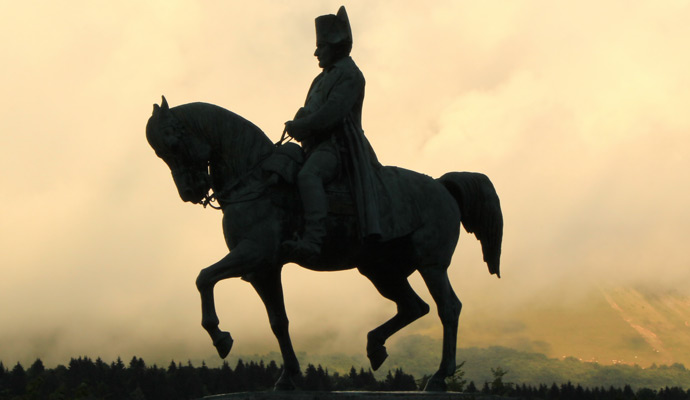Ending the Battle between Leadership and Management
Historical and fictional accounts of King Henry V show how powerful the two disciplines can be when used together.
Among the more common debates I encounter in my work is that of the art of leadership versus the science of management. Each discipline has its proponents, who are (rather unfortunately) mostly concerned about the differences between the two. Champions of leadership sometimes dismiss management as simply making the trains run on time, while proponents of management view leadership as more of an emotional discipline.
The truth is that the best managers tend to be pretty good leaders and stellar leaders know a thing or two (and usually more) about management. I look at it this way: management is the what and leadership is the why. If you have all what and no why, you wind up with a workforce just going through the motions with no real engagement. If you have great why and not enough what, the result is a lot of enthusiasm without much tangible output.
Management is the “what” and leadership is the “why.”
In an organization, people must work along a continuum that blends leadership and management to fit the situation. Everyone is expected to produce results and achieve a desired outcome, in routine operations and high-stakes crises. Doing that requires clarifying the why as well as the what. To separate them is akin to asking a top athlete whether he finds his heart or his lungs more valuable. They are both quite important together, but neither is of much use alone.
There is no better time to show the interdependency of leadership and management than as we approach Saint Crispin's Day on October 25. On this same day in 1415, the armies of England and France met in battle at Agincourt. The English army, decimated by disease, was outnumbered five to one by the French. Its soldiers were tired and it had no reinforcements, while those of the French were fresh and easily supplemented by the nearby population. And yet the English won a great victory that day, one that opened a new chapter in the Hundred Years' War. What carried the day: leadership or management?
Fans of Shakespeare know that Henry V centers on this battle and what has become known as the Saint Crispin’s Day speech is beloved as a hallmark of inspirational leadership. The staging of the speech in Kenneth Branagh’s cinematic version is a leadership masterpiece. King Henry, young and still growing into his role as monarch, stands among his troops when he starts to speak. He is one with them. As his tone and passion rise, he climbs onto a wagon with a hand from one of his lords.
Outnumbered? “The fewer the men, the greater the share of honour.
God’s will! I pray thee wish for not one man more,” he proclaims.
Afraid they will die in a futile effort? “This story shall the good man teach his son;
And Crispin Crispian shall ne’er go by,
From this day to the ending of the world,
But we in it shall be remembered.”
Tired and demoralized? “And gentlemen in England now-a-bed
Shall think themselves accurs’d they were not here,
And hold their manhoods cheap whiles any speaks
That fought with us upon Saint Crispin’s day.”
Henry rallied his men in ways that no mere manager could muster in the face of too few resources, a lack of personnel, and unfavorable market conditions. Unlike the French king who stayed safe in his castle, Henry was fighting at the front lines. This is a story of leadership!
What the play and the movie gloss over are the details of the battle—a story, according to scholars, of remarkable management: Henry assembled an army that relied heavily on archers using the longbow rather than the more common crossbow. Unusually, they outnumbered foot soldiers or cavalry. These archers were able to shoot arrows quickly and at great range, reaching behind the battle line to neutralize the ability of the French to reinforce their fighters at the front. Henry stopped his army at a narrow point in the field flanked by a forest, which further negated France’s numerical advantage and prevented flanking attacks. At the point of engagement, the English put sharp stakes in the ground that impaled the horses of the French creating a bloody blockage for the French foot soldiers. The English infantry had pikes—long thrusting spears—a foot longer than those carried by the French and so they were able to strike first, often fatally.
It had rained prior to the battle and, like a wily football coach, Henry took full advantage of the conditions on the field. The heavily armored French had difficulty with their footing and, when they fell, they often couldn't get back up because of the weight of their gear. Some who fell forward drowned in the mud. The forces became so densely packed that it became difficult to use their weapons, and the lightly armored English found themselves with the advantage of agility. At the conclusion of the battle, the French suffered between 4,000 and 10,000 dead and the English somewhere between 100 and 1,500. Clearly, management won the day!
We will never know if Henry was as eloquent in the field as Shakespeare gives him credit for—probably not. And there was also a certain amount of luck that aided any management acumen. But taken together, these two accounts show a complete picture of how a well-led and well-managed group of individuals can cohere into an unstoppable force. Leadership imbues the task at hand with meaning through a larger purpose while management creates the conditions for success.
“We few, we happy few, we band of brothers;
For he to-day that sheds his blood with me
Shall be my brother…”
Today’s executives ask for loyalty and engagement, but too few are willing to give enough of themselves and take the personal risks necessary to garner the commitment that good King Harry inspired. Too few are ready to undertake the demands of leadership and management.
Are you?




